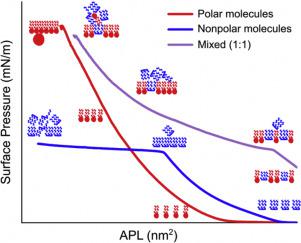当前位置:
X-MOL 学术
›
BBA Biomembr.
›
论文详情
Our official English website, www.x-mol.net, welcomes your
feedback! (Note: you will need to create a separate account there.)
Mixed polar-nonpolar lipid films as minimalistic models of Tear Film Lipid Layer: A Langmuir trough and fluorescence microscopy study.
Biochimica et Biophysica Acta (BBA) - Biomembranes ( IF 2.8 ) Pub Date : 2020-03-31 , DOI: 10.1016/j.bbamem.2020.183300 Agnieszka Olżyńska 1 , Alicja Wizert 2 , Martin Štefl 1 , D Robert Iskander 2 , Lukasz Cwiklik 3
Biochimica et Biophysica Acta (BBA) - Biomembranes ( IF 2.8 ) Pub Date : 2020-03-31 , DOI: 10.1016/j.bbamem.2020.183300 Agnieszka Olżyńska 1 , Alicja Wizert 2 , Martin Štefl 1 , D Robert Iskander 2 , Lukasz Cwiklik 3
Affiliation

|
The Tear Film Lipid Layer (TFLL) covering the surface of the aqueous film at human cornea forms a first barrier between the eye and environment. Its alterations are related to dry eye disease. TFLL is formed by a complex mixture of lipids, with an excess of nonpolar components and a minor fraction of polar molecules. Its thickness is up to 160 nm, hence a multilayer-like structure of TFLL is assumed. However, details of TFLL organization are mostly unavailable in vivo due to the dynamic nature of the human tear film. To overcome this issue, we employ a minimalistic in vitro lipid model of TFLL. We study its biophysical characteristics by using a combination of the Langmuir trough with fluorescence microscopy. The model consists of two-component polar-nonpolar lipid films with a varying component ratio spread on the aqueous subphase at physiologically relevant temperature. We demonstrate that the model lipid mixture undergoes substantial structural reorganization as a function of lateral pressure and polar to nonpolar lipid ratio. In particular, the film is one-molecule-thick and homogenous under low lateral pressure. Upon compression, it transforms into a multilayer structure with inhomogeneities in the form of polar-nonpolar lipid assemblies. Based on this model, we hypothesize that TFLL in vivo has a duplex polar-nonpolar structure and it contains numerous mixed lipid aggregates formed because of film restructuring. These findings, despite the simplified character of the model, seem relevant for TFLL physiology as well as for understanding pathological conditions related to the lipids of the tear film.
中文翻译:

混合极性-非极性脂质膜作为泪膜脂质层的简约模型:Langmuir槽和荧光显微镜研究。
覆盖人角膜上水膜表面的泪膜脂质层(TFLL)在眼睛和环境之间形成了第一道屏障。其改变与干眼病有关。TFLL由脂质的复杂混合物形成,脂质具有过量的非极性成分和少量的极性分子。其厚度最大为160nm,因此假定为TFLL的多层状结构。然而,由于人泪膜的动态性质,TFLL组织的细节在体内大部分是不可用的。为克服此问题,我们采用了TFLL的简约体外脂质模型。我们通过结合使用Langmuir槽和荧光显微镜研究其生物物理特性。该模型由两组分的极性-非极性脂质膜组成,该组分在生理相关温度下在水相上具有不同的组分比分布。我们证明,模型脂质混合物经历侧向压力和极性与非极性脂质比率的函数的实质性结构重组。特别地,该膜在低侧压力下为一分子厚且均质的。压缩后,它转变为具有极性-非极性脂质组装体形式的不均匀性的多层结构。基于此模型,我们假设体内的TFLL具有双极性-非极性结构,并且包含许多由于膜重构而形成的混合脂质聚集体。这些发现,尽管模型具有简化的特征,
更新日期:2020-04-20
中文翻译:

混合极性-非极性脂质膜作为泪膜脂质层的简约模型:Langmuir槽和荧光显微镜研究。
覆盖人角膜上水膜表面的泪膜脂质层(TFLL)在眼睛和环境之间形成了第一道屏障。其改变与干眼病有关。TFLL由脂质的复杂混合物形成,脂质具有过量的非极性成分和少量的极性分子。其厚度最大为160nm,因此假定为TFLL的多层状结构。然而,由于人泪膜的动态性质,TFLL组织的细节在体内大部分是不可用的。为克服此问题,我们采用了TFLL的简约体外脂质模型。我们通过结合使用Langmuir槽和荧光显微镜研究其生物物理特性。该模型由两组分的极性-非极性脂质膜组成,该组分在生理相关温度下在水相上具有不同的组分比分布。我们证明,模型脂质混合物经历侧向压力和极性与非极性脂质比率的函数的实质性结构重组。特别地,该膜在低侧压力下为一分子厚且均质的。压缩后,它转变为具有极性-非极性脂质组装体形式的不均匀性的多层结构。基于此模型,我们假设体内的TFLL具有双极性-非极性结构,并且包含许多由于膜重构而形成的混合脂质聚集体。这些发现,尽管模型具有简化的特征,











































 京公网安备 11010802027423号
京公网安备 11010802027423号